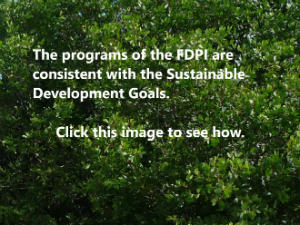By Lloyd Gardner January 1, 2012
Green spaces were traditionally included in urban development to achieve objectives such as aesthetics (verges and gardens), provision of recreational opportunities (gardens, camp grounds, playing fields, urban parks), and delineation of particular land uses (e.g. green belts used to demarcate residential areas or set city limits). Green spaces contribute to an urban community’s development in diverse ways, spanning the economic, spiritual, and social spheres of community dynamics. As such, it is not uncommon in larger Caribbean cities to find green spaces designed for purposes such as providing recreational opportunities for tourism, hosting concerts, and as places of contemplation. To a lesser degree, the ecological values of green spaces are also being utilized for purposes such as pollution filters and flood control.
The social, economic, and cultural values provided by green spaces include recreation, health benefits, provision of goods and services (e.g. wood and water), cleaner air, psychological well-being, and increased real estate values. The April 2011 designation of the St. Kitts National Capitol Park for the purpose of protecting the Basseterre Valley Aquifer is the most recent use of green space to protect critical resources.
Yet urban green spaces in the Caribbean are consistently under threat; verges and playing fields lost to commercial activities (e.g. shops, community garages), gardens in ruin from inadequate allocation of public resources for maintenance, re-zoning of land for residential and commercial use, and from natural causes.
The loss is compounded by the fact that some green spaces are not easily defined within the context of small islands, and are thus not fully appreciated. Of the various types of green spaces typically found in urban areas in Caribbean nations, urban forests are the least defined in space and concept, yet their contribution is probably the most diverse and significant of all types of green spaces. They provide a wider range of ecological and economic benefits, and are able to withstand significant natural shock (e.g. the ability of coastal forests to act as buffers during storm events). Even within the typology of urban forests, coastal forests require special attention.
Coastal forests are generally high in biological diversity, provide ecological services that form the basis of economic activities (e.g. eco-tours and fishing), and are extremely fragile. Threats to fragile coastal forests include deforestation for land development, sedimentation from upland runoff, damage from storms, and now, sea level rise.
The lack of appreciation of the value of urban green spaces has also resulted in the lack of data on the level of transformation of green spaces, the abundance and uses of associated resources, and the value of the contributions to urban communities. Ironically, this lack of data limits the ability of public sector managers to make informed decisions concerning urban land uses and design at a time when there is increasing urbanization in the Caribbean.
It would probably be useful for planning professionals to define urban forests in the Caribbean context, and to assess the various contributions of urban green spaces to Caribbean communities.
Lloyd Gardner is an environmental planning consultant and President of the Foundation for Development Planning, Inc.

No Comments Yet - be the First!